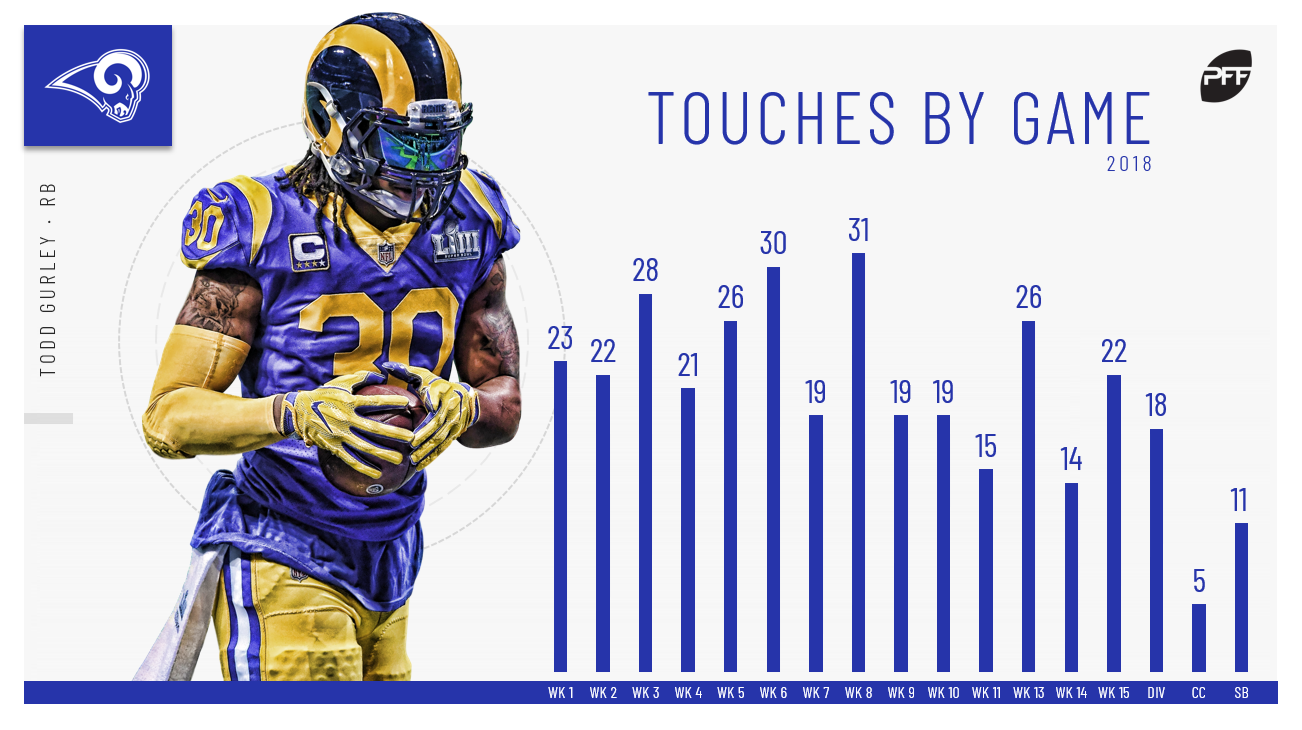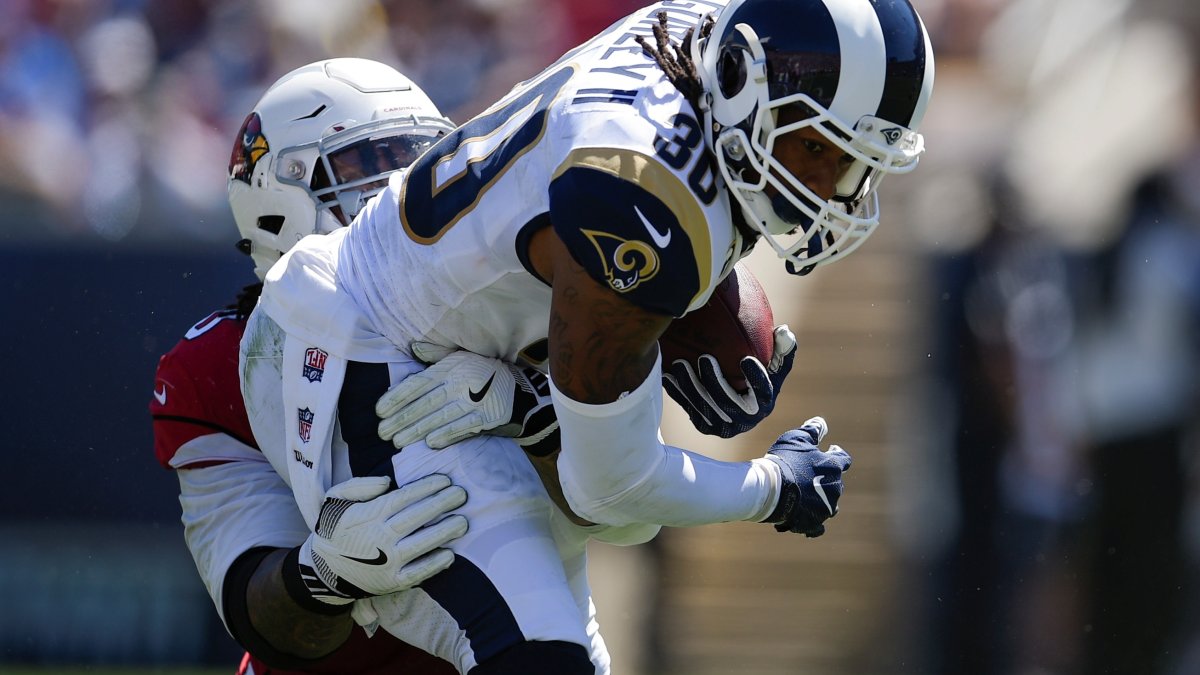Todd Gurley’s 2019 fantasy football value has been one of the most polarizing topics of the offseason. Fear over the severity of his knee injury has caused some fantasy industry pundits to drop Gurley significantly in their rankings. But the way to win in fantasy is to react, not overreact. So let’s take a look at what we know and evaluate Gurley’s 2019 fantasy football outlook.
After ranking as the No. 1 fantasy running back in 2017, Gurley came storming out of the gates last season. He posted top-10 numbers in each of the first nine games with an average fantasy finish of 4.1 among running backs over that span. He also touched the ball a ton over that stretch with a whopping 24.3 touches per game. That heavy volume was a very likely a contributing factor in Gurley’s late-season injury woes.
Gurley’s late-season decline happened quickly. He emerged from the Rams’ Week 12 bye with a strong outing against the Lions. But then in Week 14, Gurley posted his lone fantasy dud of the season against the Bears. Just two weeks later he was on the sideline for the fantasy championships where fantasy owners had to watch a rotund C.J. Anderson rack up 167 rushing yards and a score. To make matters worse, Gurley limped his way through the postseason, and was essentially a non-factor in the Super Bowl.
The Rams’ playoff run really highlights a big part of the dilemma surrounding Gurley for fantasy purposes. Everyone knew something was wrong with him, but the Rams didn’t give us any indication of that that something was. Instead they insisted he was fine. And to a large extent, they’ve keep up this façade in the offseason, with Sean McVay publicly endorsing Gurley as the “focal point” of the offense.
NFL teams can lie to us in interviews and pressers, but it’s really hard for them to not tell the truth in the NFL draft. The truth the Rams told is that running back was enough of a priority for them that they spent a Day 2 pick on the exciting Darrell Henderson. In the wake of the draft, there have been continual rumblings that Gurley’s workload will be reduced. And it’s precisely here where we as fantasy players need to react and not overreact.
Whether we like it or not, NFL teams do not care about our fantasy rosters. The Rams don’t give a darn that Gurley finished as the No. 3 fantasy running back last season. All of the teams in the league have the same objective: winning the Super Bowl. And the Rams were as close as you can come to accomplishing that goal last season. While we can’t argue that Gurley’s ailing health was the sole reason why they lost, it certainly wouldn’t have hurt their cause if he was fully healthy. And how you increase your chances of keeping running backs healthy is by limiting their workload.
Here’s where Henderson comes into play. The Rams really didn’t have a complementary piece in the backfield last season. Former sixth-rounder John Kelly flashed in the preseason, but he wasn’t able to fill that role. Henderson has similarities to Kelly from an overall standpoint, but he is much more explosive and dynamic. So while there’s a perspective among some in the fantasy industry that Henderson is a potential Gurley replacement, it’s much more likely that he’s a complimentary piece that gives the Rams a significant pop out of the backfield.
That’s a crucial distinction that often gets lost in the shuffle of our 24-hour football news cycle. As fantasy players, we often have to translate football news into meaningful information. Quite often we hear how a team “loves” a player, but that doesn’t always mean that we should share those same feelings for fantasy purposes. With Henderson, the Rams have publicly stated how much they like what he can do on the field, but that doesn’t necessary mean we should be viewing Henderson as a fifth-round fantasy pick.
We can roughly estimate that Rams running backs will see in the range of a combined 450 touches this season. That’s an average of just over 28 per game. Gurley’s usage over the first nine weeks of last season would equate to an enormous 86.6% of that workload. As we saw last year, that’s simply unsustainable. Reducing his workload to an average of 18 touches per game would put him at a much more reasonable 64%. We can then project Henderson in the range of 26-30% with the remaining slice of the pie going to the rest of the backfield.
With that touch distribution, Henderson would come in at 7-10 touches per game. Looking back to last season, the highest fantasy finished who averaged under 10 touches per game was Nyheim Hines, who ranked 28th. Jalen Richard was right behind him at 29, but both players notched over 60 catches. Given the expectations in this backfield, we don’t expect Henderson to approach that sort of volume as a receiver. A better statistical comp might be Mike Davis, who finished 36th in fantasy scoring with 34 catches and 112 carries for an average of 9.7 touches per game.
There’s no denying Henderson’s upside, but this sort of workload isn’t enough to sustain consistent fantasy production. Given the information we currently have, it’s best to view him as a weekly boom-or-bust option with premium handcuff value. In terms of draft day value, Henderson currently has an eighth-round PPR grade on my initial draft board.

In terms of Gurley, there’s no denying the fact that a reduction in touches decreases his fantasy value, but the question is how much? An average of 18 touches per game equates to 288 over the course of 16 games. While that’s below the bell cow range of 20-plus per game, backs with that type of workload are rare in today’s NFL. Last season, only five backs averaged greater than 20 touches per game: Ezekiel Elliott (25.4), Gurley (22.5), Saquon Barkley (22.0), James Conner (20.8), and Christian McCaffrey (20.4). Joe Mixon was also close at 19.9.
An average of 18 touches per game would have ranked Gurley just outside the top-10 last season, but other running backs has shown the ability to be very productive with similar volume. Alvin Kamara averaged 18.3 touches per game last season and finished as the No. 4 fantasy back thanks to his impressive efficiency. Kamara averaged 1.27 fantasy points per touch, which was third highest among running backs with at least 10 touches per game. But Gurley was no slouch in this department with 1.17 fantasy points per touch, which tied for seventh-highest.
So if we take Gurley’s per-touch efficiency and combine that with his expected touches, we get an average of 21.1 PPR points per game. While that’s over five points fewer than Gurley averaged last year, it still would have ranked seventh among running backs in 2018. Only Bakley (24.0), McCaffrey (24.0), Kamara (23.2), Melvin Gordon (22.6), Elliott (22.1), and Conner (21.5) averaged more fantasy points per game.
While Gurley’s days as an elite bell cow back may be in the past, the situation in Los Angeles doesn’t necessarily warrant as much concern as some in the fantasy industry might lead you to believe. Sure, his touches are almost certainly going to be reduced. But the Rams aren’t going to shift their backfield to a full-blown committee in 2019.
Henderson is best viewed as a complementary piece who has moderate independent fantasy value and offers appeal as a handcuff. Gurley is likely to slide back to the pack. But even as the seventh or eighth fantasy running back, he’s still worthy of first-round consideration in fantasy drafts right now. Of course, this is fantasy football, and things can change quickly. So always be prepared to adjust quickly to information. But for now, let everyone else overreact and look to get Gurley at a value in the second round of early fantasy drafts.




 © 2025 PFF - all rights reserved.
© 2025 PFF - all rights reserved.